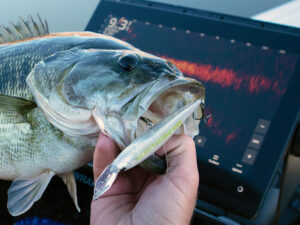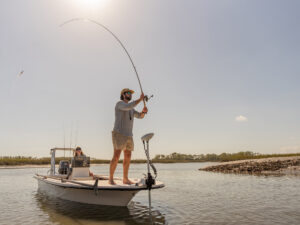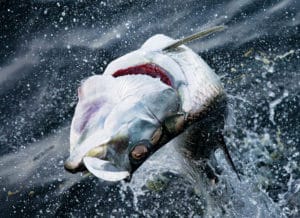
I know I’m not the only angler who grew up fishing spinning reels, mostly ignoring baitcasters. Not because I had disdain for them, but because no one in my fishing circle used them. Why use a baitcaster when none of my fishing mates used them? I was catching fish, no problem. That all changed in the past decade.
A heavy mix of topwater-plug fishing, Gulf Coast inshore fishing and freshwater bass fishing brought to light the versatility and enjoyment of the revolving-spool, star-drag reels. Now, I consider myself a late adopter, and I’ve learned some things along the way, like exactly when to use a baitcaster.
Baitcasters necessitate touch and feel that’s simply not required with spinning reels. How to use a baitcaster takes practice initially. Get past that small snag and you’ll notice baitcaster advantages include lure-casting distance, accuracy with lighter offerings and even lure retrieves that require jerking actions.
Compact baitcasting reels feature key differentiating characteristics from spinners, such as levelwinds, lighter drags, spool-tension knobs and braking systems. When fishing, righties often cast baitcasters with their right hand, then switch the rod and reel over to their left hand and crank with their right hand. That may sound like too many motions after a cast, but I perfected the actions after a day of fishing. If I can do it, so can you.
A couple of fishing “hacks” to consider: If you have the dexterity, try cutting out some steps by casting with your left hand and reeling with your right. And if turning the handle on the right side of the reel — or working a lure with your left hand — proves too cumbersome, consider buying a lefty baitcaster. Pairing the proper casting rod and reel together is an entirely different process that’s not covered in this column. Light lures with stiff rods often necessitate a combo that’s comfortable for the angler to cast.
How to Use a Baitcaster
Reel manufacturers make it easier than ever to prevent the dreaded baitcasting blunder: the backlash. But anglers should be intimately familiar with two parts of the reel — the spool-tension knob and the brake — to help fine-tune and adjust their casts.
The spool-tension knob helps avert overruns by applying pressure to both sides of the spool. Some anglers set the tension control by tightening the knob just enough so that their lure falls slowly to the ground during free-spool.
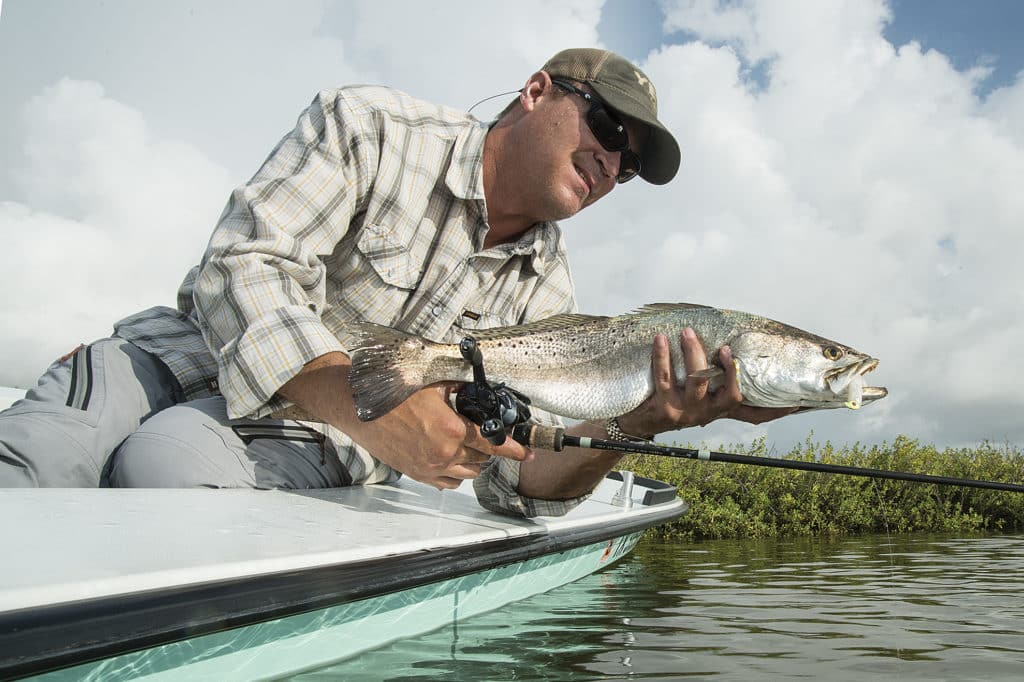
The reel’s brakes have an even larger effect on cast control.
“The two most common braking systems, centrifugal and magnetic, behave slightly differently but serve the same purpose,” says Chris Littau, senior product manager with Quantum reels. “Centrifugal brakes rely on weights. Magnetic brakes utilize electromagnetic force. No matter the brake system, the faster the spool turns, the more brake pressure applied to slow it down.”
A baitcaster’s drag system is built into its gearing. Because of this, baitcasters with high gear ratios have lower drag settings, and lower-gear-ratio reels have higher drag maxes.
“The spool turns the pinion gear, the pinion gear turns the drive gear and the drive gear holds the drag system,” says Chris Littau, with Quantum. “The fastest way to wear out a baitcaster’s drag is to force or pull line out on a heavily set drag.”
There really shouldn’t be a baitcaster vs. spinning reel battle. In fact, a balanced inshore fishing arsenal has both types of reels. With the basics of baitcasters now in your rearview mirror, check out six inshore saltwater casters that push the envelope in technology and usability. Directly below is a chart that compares specs from six different reels. Below the chart, each reel is highlighted.
| Model | Inches per Crank | Gear Ratio | Braid Line Capacity | Max Drag |
|---|---|---|---|---|
| Abu Garcia Revo Inshore Low Profile | 30 | 7.3-to-1 | 180 yards of 30-pound | 24 |
| Daiwa Coastal TWS 200 | 32.2 | 7.3-to-1 | 190 yards of 40-pound | 15.4 |
| *Okuma Komodo SS KDS-463 | 33.5 | 6.3-to-1 | 230 yards of 50-pound | 30 |
| *Quantum Smoke S3 | 36 | 5.1-to-1 | 210 yards of 30-pound | 25 |
| *Shimano Chronarch G | 30 | 7.1-to-1 | 135 yards of 30-pound | 11 |
| *13 Fishing Concept TX8.1 | 32 | 6.6-to-1 | 200 yards of 20-pound | 25 |
| Model | Ball Bearings | Weight (Ounces) | MSRP |
|---|---|---|---|
| Abu Garcia Revo Inshore Low Profile | 6+1 | 7.9 | $250 |
| Daiwa Coastal TWS 200 | 7+1 | 8.1 | $230 |
| *Okuma Komodo SS KDS-463 | 7+1 | 15.9 | $250 |
| *Quantum Smoke S3 | 10+1 | 6.9 | $170 |
| *Shimano Chronarch G | 8+1 | 6.5 | $280 |
| *13 Fishing Concept TX8.1 | 10 | 5.9 | $300 |
*Model represents slowest gear ratio in each reel line
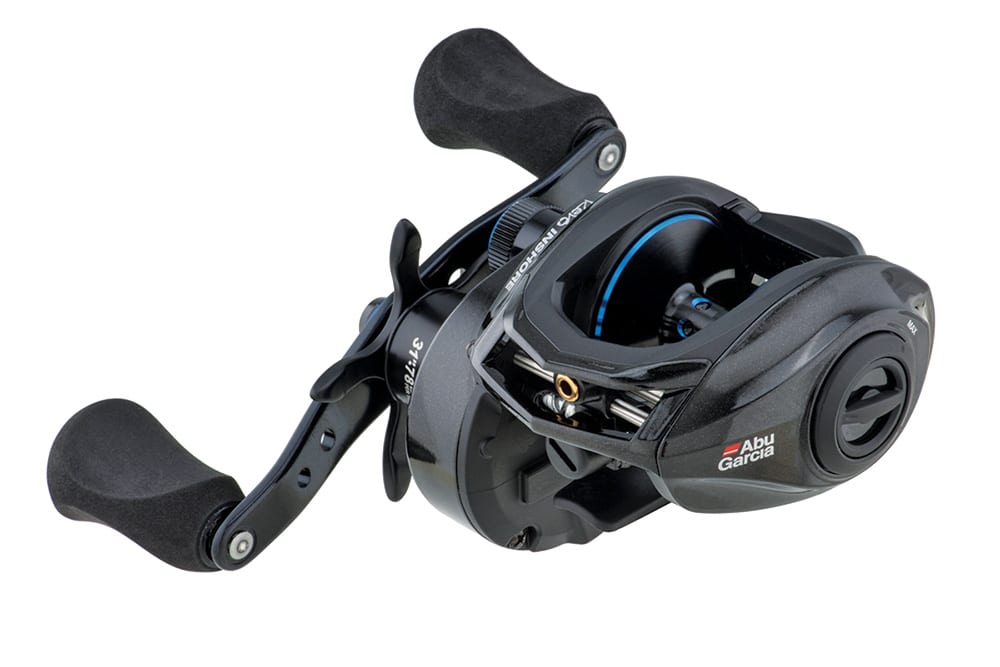
Abu Garcia Revo Inshore Low Profile
“We use specialized high-performance corrosion resistance (HPCR) bearings that resist rust and debris contamination,” says Andrew Wheeler, with Abu Garcia. “Plus, a longer 95 mm handle and oversize knob adds additional cranking power.”
An improved infinitely variable centrifugal (IVC) braking system offers anglers a wide range of adjustment. The C6 carbon palm side plate provides significant weight reduction. A power stack Carbon Matrix Drag System handles 24 pounds of drag, but also produces smooth drag pressures across the entire drag range.
“The drag washers are twice as thick as our standard drag washers to increase drag durability and resist washer distortion,” says Wheeler.
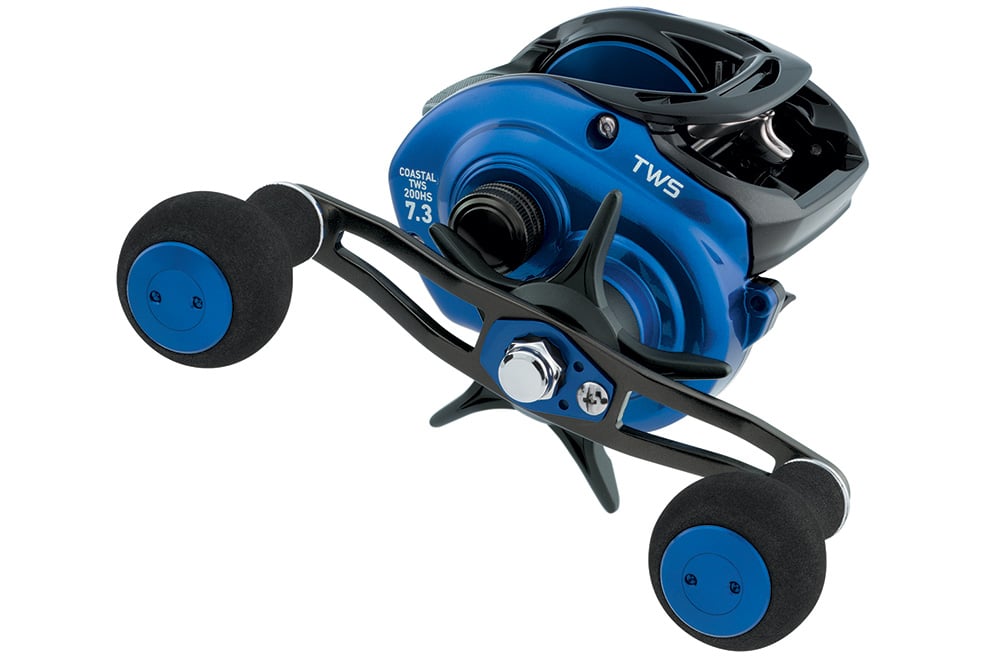
Daiwa Coastal TWS 200
Daiwa’s Coastal TWS 200 Inshore baitcaster incorporates a proprietary T-Wing System, best explained as a modified T-style levelwind with a large aperture to prevent line friction when casting. The line is forced back into a tight groove after the cast to make sure the line is positioned evenly along the spool when reeling.
Seven corrosion-resistant ball bearings and an aluminum spool and frame help fight off salt water, says Marc Mills, Daiwa’s marketing field specialist. A 100 mm handle with an EVA knob provides stout leverage when cranking. The TWS 200 spool offers 35 percent more line capacity than the 100 size.

Okuma Komodo SS
“The Komodo SS models work great for calico bass, yellowtail, white seabass and tuna in California, but just as well targeting tarpon, snook and redfish on the East Coast,” says John Bretza, director of product development at Okuma Fishing Tackle.
The “SS” in the series name stands for stainless steel. Okuma equipped Komodo models with main gear, pinion gear and shafts machined from stainless steel. Other vital features include an aluminum frame, spool and side plates.
“Different from other inshore baitcasters, our levelwind system does not disengage,” says Bretza. “With our reel, when you cast, the levelwind guide travels back and forth. This design was specifically meant for braided line and increased durability.”

Quantum Smoke Series 3
Quantum engineered a 35.5 mm spool, when the average spool size is 32 to 34 mm, into a compact frame to provide anglers with increased line capacity, longer casts and more inches of line pickup with the new Quantum Smoke Series 3 (S3). To protect against salt, the company utilized premium aluminum salt-guard multilayer corrosion protection and anti-corrosion bearings. A unique PT thumb bar also sports special coating to prevent corrosion and binding.
“Our cast-control braking system minimizes the energy it takes to get the spool spinning on a cast, along with additional brakes that disengage around 5,000 rpm to maximize distance,” says Littau.
Sixteen different cast-control adjustments are available on an easy-to-see external dial.

Shimano Chronarch G
The Chronarch G baitcaster was built with Texas wade-fishermen in mind, and is meant to tackle redfish, speckled trout and other inshore species in close-quarters conditions.
This Chronarch G model is saltwater safe, says Shimano’s John Mazurkiewicz, with a newly incorporated corrosion-resistant spool, something that wasn’t available on past Chronarch models.
Key features include micromodule guiding, a gearing system with small, precise teeth that produces smooth engagement and efficiency. An X-Ship pinion-gear support maintains precise alignment with the gear drive for powerful retrieves under heavy loads. Lastly, the SVS Infinity brakes are dialed in for better cast control, spool control and brake force.

13 Fishing Concept TX
The 13 Fishing Concept TX series baitcasters are made specifically for saltwater use.
“It’s not the design that makes reels saltwater specific, but the quality of materials and protection processes,” says Matt Baldwin, product-development director of 13 Fishing. “Our saltwater-specific reels feature Ocean Armor 2 on aluminum frames, corrosion-resistant bearings throughout the reel and attention to materials on the small parts that could be affected by the harsh saltwater environment.”
Gear ratios are important to the angler, and Baldwin has noticed a trend toward higher-speed reels.
“I suggest, if battling inshore species with live bait, purchase a 6.6-to-1 reel,” he says. “If you work a lot of artificial baits, 7.3-to-1 is the sweet spot in our lineup.” 13 Fishing offers specialty TX reels in three gear ratios.

